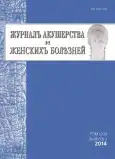Активность овариальной ароматазы у больных синдромом поликистозных яичников
- Авторы: Николаенков И.П.1, Потин В.В.1, Тарасова М.А.1, Ткаченко Н.Н.1, Ярмолинская М.И.1, Тимофеева Е.М.1, Самойлович Я.А.1
-
Учреждения:
- ФГБУ «НИИАГ им. Д. О. Отта» СЗО РАМН
- Выпуск: Том 63, № 1 (2014)
- Страницы: 10-16
- Раздел: Статьи
- URL: https://journals.rcsi.science/jowd/article/view/2704
- DOI: https://doi.org/10.17816/JOWD63110-16
- ID: 2704
Цитировать
Полный текст
Аннотация
Ключевые слова
Полный текст
Открыть статью на сайте журналаОб авторах
Игорь Павлович Николаенков
ФГБУ «НИИАГ им. Д. О. Отта» СЗО РАМН
Email: Nikolaenkov_igor@mail.ru
аспирант
Владимир Всеволодович Потин
ФГБУ «НИИАГ им. Д. О. Отта» СЗО РАМН
Email: iagmail@ott.ru
з. д. н. РФ, профессор, руководитель отделения гинекологической эндокринологии
Марина Анатольевна Тарасова
ФГБУ «НИИАГ им. Д. О. Отта» СЗО РАМН
Email: tarasova@ott.ru
д. м. н., профессор
Наталья Николаевна Ткаченко
ФГБУ «НИИАГ им. Д. О. Отта» СЗО РАМНк. м. н., старший научный сотрудник. Заведующая гормональной лабораторией отдела эндокринологии репродукции
Мария Игоревна Ярмолинская
ФГБУ «НИИАГ им. Д. О. Отта» СЗО РАМН
Email: m.yarmolinskaya@gmail.com
д. м. н., в. н. с. отдела эндокринологии репродукции
Екатерина Михайловна Тимофеева
ФГБУ «НИИАГ им. Д. О. Отта» СЗО РАМН
Email: katisun@rambler.ru
врач клинической лабораторной диагностики
Янина Андреевна Самойлович
ФГБУ «НИИАГ им. Д. О. Отта» СЗО РАМН
Email: yanasam@yandex.ru
аспирант
Список литературы
- Беляков Н. А., Чубриева С. Ю., Глухов Н. В. Инсулинорезистентность и синдром поликистозных яичников. Часть II. Патогенез, роль гиперинсулинемии и гиперандрогенемии, генетическая взаимосвязь. Эфферентная терапия. 2002; 8 (3): 16-29.
- Дедов И. И., Мельниченко Г. А. ред. Синдром поликистозных яичников: руководство для врачей. М.: МИА; 2007.
- Денисова В. М. Эффективность агониста гонадотропин-рилизинг гормона в терапии эндометриоза. Журнал акушерства и женских болезней. 2013; 5: 29-34.
- Савина В. А. Овариальная ароматаза р450 при нормогонадотропной недостаточности яичников. Журнал акушерства и женских болезней. 2012; 1: 84-9.
- Савина В. А., Кветной И. М., Клещев М. А., Потин В. В., Рулев В. В., Тарасова М. А., Ткаченко Н. Н., Ярмолинская М. И. Овариальная ароматаза р450 при синдроме поликистозных яичников. Медицинский академический журнал. 2012; 12 (1): 66-72.
- Савина В. А., Швед Н. Ю., Потин В. В., Тарасова М. А., Ярмолинская М. И., Иващенко Т. Э., Баранов В. С. Аллельные варианты гена CYP19 (ароматазы р450) и активность ароматазы р450 у больных синдромом поликистозных яичников. Медицинская генетика. 2012; 4: 36-41.
- Badawy A., Elnashar A. Treatment options for polycystic ovary syndrome. Int. J. Womens Health. 2011; 3: 25-35.
- Deb S., Campbell B. K., Pincott-Allen C. et al. Quantifying effect of combined oral contraceptive pill on functional ovarian reserve as measured by serum anti-Müllerian hormone and small antral follicle count using three-dimensional ultrasound. Ultrasound. Obstet. Gynecol. 2012; 39 (5): 574-80.
- Poli F., Dreno B., Verschoore M. An epidemiological study of acne in female adults: results of a survey conducted in France. J. Eur. Acad. Dermatol. Venereol. 2001;15 (6): 541-5.
- Dunaif A. Insulin resistance and the polycystic ovary syndrome: mechanism and implications for pathogenesis. Endocr. Rev. 1997; 18: 774-800.
- Ehrmann D. A., Cavaghan M. K., Imperial J. et al. Effects of metformin on insulin secretion, insulin action, and ovarian steroidogenesis in women with polycystic ovary syndrome. J. Clin. Endocrinol. Metab. 1997; 82 (2): 524-30.
- Fitzpatrick S. L., Richards J. S. Regulation of cytochrome P450 aromatase messenger ribonucleic acid and activity by steroids and gonadotropins in rat granulosa cells. Endocrinology. 1991; 129 (3): 1452-62.
- Grossman M., Nakajima S., Fallat M., Siow Y. Müllerian inhibiting substance inhibits cytochrome P450 aromatase activity in human granulosa lutein cell culture. Fertil. Steril. 2008; 89: 1364-70.
- Santen R. et al. History of aromatase: saga of an important biological mediator and therapeutic target. J. Endocr. Rev. 2009; 30 (4): 343-75.
- Ji Hee Yoo, Hye Ok Kim, Sun Wha Cha et al. Age specific serum anti-Müllerian hormone levels in 1,298 Korean women with regular menstruation. Clin. Exp. Reprod. Med. 2011; 38 (2): 93-7.
- Jones M. E., Boon W. C., McInnes K. et al. Recognizing rare disorders: aromatase deficiency. Nat. Clin. Pract. Endocrinol. Metab. 2007; 3: 414-21.
- Laven J. S. E., Mulders A. M., Visser J. et al. Anti-Müllerian hormone serum concentrations in normoovulatory and anovulatory women of reproductive age. J. Clin. Endocrinol. Metabolism. 2004; 89: 318-23.
- Lobo R. A., Carmina E. The importance of diagnosing the polycystic ovary syndrome. Annals of Internal medicine. 2000; 132 (12): 989-93.
- Morisihima A., Grumbach M. M., Simpson E. R. et al. Aromatase deficiency in male and female siblings caused by a novel mutation and the physiological role of estrogens. J. Clin. Endocrinol. Metab. 1995; 80: 3689-98.
- Nilsson E. E., Schindler R., Savenkova M. I., Skinner M. K. Inhibitory actions of anti-Müllerian hormone (AMH) on ovarian primordial follicle assembly. PLoS One. 2011; 6 (5): 20087.
- Pellatt L., Rice S., Mason H. D. Anti-Müllerian hormone and polycystic ovary syndrome: a mountain too high? Reproduction. 2010; 139 (5): 825-33.
- Rotterdam E. Revised 2003 consensus on diagnostic criteria and long-term health risks related to polycystic ovary syndrome. Fertil. Steril. 2004; 81 (1): 19-25.
- Stewart P. M., Krozowski Z. S. 11 beta-hydroxysteroid dehydrogenase. Vitam. Horm. 1999; 57: 249-324.
- Van Rooij I. A., Broekmans F. J., te Velde E. R. et al. Serum anti-Müllerian hormone levels: a novel measure of ovarian reserve. Hum. Reprod. 2002; 17: 3065-71.
Дополнительные файлы







